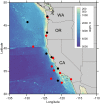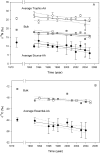Carbon and nitrogen isotopes from top predator amino acids reveal rapidly shifting ocean biochemistry in the outer California Current
- PMID: 25329915
- PMCID: PMC4201512
- DOI: 10.1371/journal.pone.0110355
Carbon and nitrogen isotopes from top predator amino acids reveal rapidly shifting ocean biochemistry in the outer California Current
Abstract
Climatic variation alters biochemical and ecological processes, but it is difficult both to quantify the magnitude of such changes, and to differentiate long-term shifts from inter-annual variability. Here, we simultaneously quantify decade-scale isotopic variability at the lowest and highest trophic positions in the offshore California Current System (CCS) by measuring δ15N and δ13C values of amino acids in a top predator, the sperm whale (Physeter macrocephalus). Using a time series of skin tissue samples as a biological archive, isotopic records from individual amino acids (AAs) can reveal the proximate factors driving a temporal decline we observed in bulk isotope values (a decline of ≥1 ‰) by decoupling changes in primary producer isotope values from those linked to the trophic position of this toothed whale. A continuous decline in baseline (i.e., primary producer) δ15N and δ13C values was observed from 1993 to 2005 (a decrease of ∼4‰ for δ15N source-AAs and 3‰ for δ13C essential-AAs), while the trophic position of whales was variable over time and it did not exhibit directional trends. The baseline δ15N and δ13C shifts suggest rapid ongoing changes in the carbon and nitrogen biogeochemical cycling in the offshore CCS, potentially occurring at faster rates than long-term shifts observed elsewhere in the Pacific. While the mechanisms forcing these biogeochemical shifts remain to be determined, our data suggest possible links to natural climate variability, and also corresponding shifts in surface nutrient availability. Our study demonstrates that isotopic analysis of individual amino acids from a top marine mammal predator can be a powerful new approach to reconstructing temporal variation in both biochemical cycling and trophic structure.
Conflict of interest statement
Figures



Similar articles
-
POPs in free-ranging pilot whales, sperm whales and fin whales from the Mediterranean Sea: Influence of biological and ecological factors.Environ Res. 2015 Oct;142:185-96. doi: 10.1016/j.envres.2015.06.021. Epub 2015 Jul 8. Environ Res. 2015. PMID: 26162962
-
Pacific Ocean-wide profile of CYP1A1 expression, stable carbon and nitrogen isotope ratios, and organic contaminant burden in sperm whale skin biopsies.Environ Health Perspect. 2011 Mar;119(3):337-43. doi: 10.1289/ehp.0901809. Epub 2010 Dec 6. Environ Health Perspect. 2011. PMID: 21134820 Free PMC article.
-
Stable isotope ratios of carbon, nitrogen and sulphur and mercury concentrations as descriptors of trophic ecology and contamination sources of Mediterranean whales.Chemosphere. 2019 Dec;237:124448. doi: 10.1016/j.chemosphere.2019.124448. Epub 2019 Jul 24. Chemosphere. 2019. PMID: 31398606
-
Tree-ring stable isotopes and historical perspectives on pollution--an overview.Environ Pollut. 2010 Jun;158(6):2007-13. doi: 10.1016/j.envpol.2009.11.031. Epub 2009 Dec 21. Environ Pollut. 2010. PMID: 20022153 Review.
-
'Trophic' and 'source' amino acids in trophic estimation: a likely metabolic explanation.Oecologia. 2017 Jun;184(2):317-326. doi: 10.1007/s00442-017-3881-9. Epub 2017 Jun 6. Oecologia. 2017. PMID: 28584941 Free PMC article. Review.
Cited by
-
Reductions in the dietary niche of southern sea otters (Enhydra lutris nereis) from the Holocene to the Anthropocene.Ecol Evol. 2020 Mar 10;10(7):3318-3329. doi: 10.1002/ece3.6114. eCollection 2020 Apr. Ecol Evol. 2020. PMID: 32273989 Free PMC article.
-
Temporal variation in pelagic food chain length in response to environmental change.Sci Adv. 2017 Oct 18;3(10):e1701140. doi: 10.1126/sciadv.1701140. eCollection 2017 Oct. Sci Adv. 2017. PMID: 29057322 Free PMC article.
-
Amino acid δ15N underestimation of cetacean trophic positions highlights limited understanding of isotopic fractionation in higher marine consumers.Ecol Evol. 2020 Mar 4;10(7):3450-3462. doi: 10.1002/ece3.6142. eCollection 2020 Apr. Ecol Evol. 2020. PMID: 32274001 Free PMC article.
References
-
- Checkley JDM, Barth JA (2009) Patterns and processes in the California Current System. Prog Oceanogr 83: 49–64.
-
- Bograd SJ, William JS, Barlow J, Booth A, Brodeur RD, et al... (2010) Status and trends of the California Current region, 2003–2008. PICES Special Publication. 106–141 p.
-
- McGowan JA, Bograd SJ, Lynn RJ, Miller AJ (2003) The biological response to the 1977 regime shift in the California Current. Deep Sea Res II 50: 2567–2582.
-
- Brinton E, Townsend A (2003) Decadal variability in abundances of the dominant euphausiid species in southern sectors of the California Current. Deep Sea Res II 50: 2449–2472.
-
- Chavez FP, Ryan J, Lluch-Cota SE, Ñiquen CM (2003) From anchovies to sardines and back: Multidecadal change in the Pacific Ocean. Science 299: 217–221. - PubMed
Publication types
MeSH terms
Substances
LinkOut - more resources
Full Text Sources
Other Literature Sources

